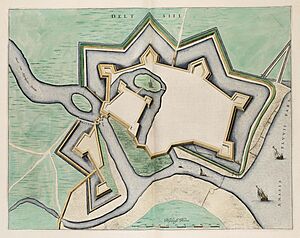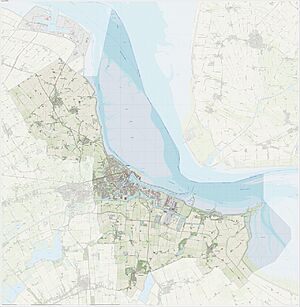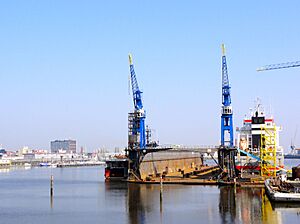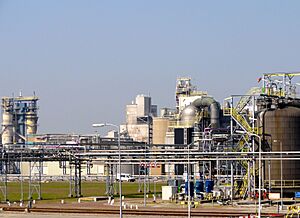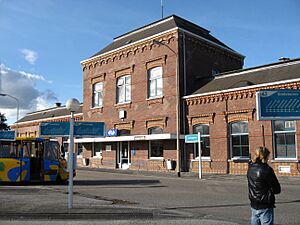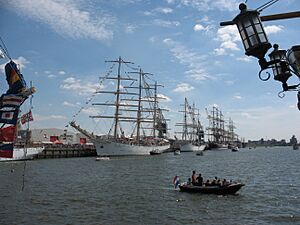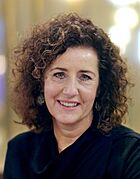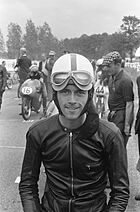Delfzijl facts for kids
Quick facts for kids
Delfzijl
Delfsiel (Gronings)
|
|||
|---|---|---|---|
|
City
|
|||
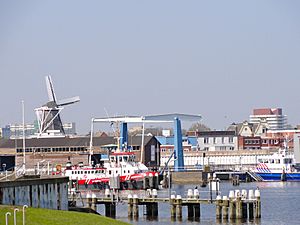
Skyline of Delfzijl in 2011
|
|||
|
|||
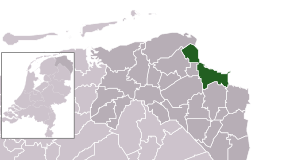
Location in the province of Groningen
|
|||
| Country | Netherlands | ||
| Province | Groningen | ||
| Municipality | Eemsdelta | ||
| Area | |||
| • Total | 227.50 km2 (87.84 sq mi) | ||
| • Land | 133.06 km2 (51.37 sq mi) | ||
| • Water | 94.44 km2 (36.46 sq mi) | ||
| Elevation | 1 m (3 ft) | ||
| Population
(May 2014)
|
|||
| • Total | 25,651 | ||
| • Density | 193/km2 (500/sq mi) | ||
| Demonym(s) | Delfzijler | ||
| Time zone | UTC+1 (CET) | ||
| • Summer (DST) | UTC+2 (CEST) | ||
| Postcode |
Parts of 9900 range
|
||
| Area code | 0596 | ||
Delfzijl is a city in the northeast of the Netherlands. It is located in the province of Groningen. Once a separate town, Delfzijl now belongs to the larger municipality of Eemsdelta. About 25,000 people live here.
Delfzijl started as a special water gate, called a sluice. This sluice connected two important waterways: the Delf canal and the Ems river. In the 1500s, it became a protected settlement with strong walls. These walls were later removed in the late 1800s. Today, Delfzijl is a very important seaport. It is the fifth largest port in the Netherlands and the biggest in the northeast part of the country.
Contents
What Does the Name Delfzijl Mean?
The name Delfzijl tells us about its history. It means 'sluice of the Delf'. The Delf was a canal that linked the Fivel and Ems rivers. Now, it is part of a larger canal called the Damsterdiep.
The Dutch word delven means 'to dig'. The word zijl means 'water outlet' or 'sluice'. So, the name literally means 'the water gate of the dug canal'.
A Look Back: History of Delfzijl
Delfzijl began where three sluices met. In 1317, the first sluice was built in the Delf canal. This canal is now part of the Damsterdiep. Since medieval times, Delfzijl has been the main seaport for the city of Groningen.
In 1580, a square fort, called a sconce, and a church were built. The defenses grew stronger in 1591 with six bastions. That same year, Prince Maurice of Orange visited with 150 ships. His Dutch and English army captured the city from the Spanish.
Later, in 1594, an attempt to capture Delfzijl by Francisco Verdugo failed. In 1628, the famous admiral Piet Hein brought his "silver fleet" to Delfzijl. The first sea battle of the Eighty Years' War happened nearby in 1658. Dutch ships under Admiral Michiel de Ruyter also used Delfzijl in 1665 to avoid the English fleet.
The strong walls and sluices were damaged during a big flood in 1717. From 1813 to 1814, the French army held the city while the Dutch tried to take it back. In 1875, the old fortifications were removed. This made space for a train station. Part of the old moat was kept for fun, like ice skating in winter.
Delfzijl was damaged during World War II. You can still find reminders of the battle, like monuments and old bunkers. The waterfront area is being rebuilt to make Delfzijl a better place for tourists. This construction also helps protect the town from sea flooding.
Delfzijl is mostly above sea level. But it is still protected by dikes and gates. These gates can open to let water out at low tide. They close to stop flooding at high tide. If normal draining is not enough, water is pumped out. A modern pumping station near Farmsum helps with this. Rising sea levels are a big worry for Delfzijl. The dikes are being made taller to keep the town safe.
In the past, Delfzijl had industries like grain milling and brick making. Now, it has newer industries and technologies. The town also has a mix of cultures. You can find Indonesian food and different groups of people living together.
Near Delfzijl, there is a church in Uitwierde that is about 800 years old. It sits on an old artificial mound. This mound was built long ago, before dikes protected the land. The church's pipe organ was moved there in 1975. The area also has old farmhouses and villages with historic churches.
Some old villages like Weiwerd and Heveskes were removed in the 1970s. This happened to make space for new industries. You can still see photos and monuments that remember these villages. An ancient tomb from 3400 BC was found in Heveskes. The village of Oterdum was also removed in the 1970s. This was done to make the dike higher and safer.
Where is Delfzijl Located?
Delfzijl is in the northeast of the Groningen province. It is in the northeast of the Netherlands. The city is on the southwest bank of the Ems river mouth. This river forms the border with Germany.
The former municipality of Delfzijl included several towns and villages:
- Bierum
- Biessum
- Borgsweer
- Delfzijl
- Farmsum
- Godlinze
- Holwierde
- Krewerd
- Losdorp
- Meedhuizen
- Spijk
- Termunten
- Termunterzijl
- Uitwierde
- Wagenborgen
- Weiwerd
- Woldendorp
How Does Delfzijl Make Money?
The Port of Delfzijl is very important for the economy. It is the fifth largest seaport in the Netherlands. An aluminium factory, part of Tata Steel Europe, is located here. In 2004, this factory made a record 112,400 tonnes of liquid aluminum.
Delfzijl is also known for its chemical industry. A large salt production plant, run by AkzoNobel, is in the area. There is a big industrial site of 3 square kilometers. This site is one of the largest employers in the region. It exports a lot of chemicals, especially chlorine.
Strong winds in the area are used to make electricity. Modern wind turbines create clean energy. Old windmills are now mostly used for special events.
A modern canal connects Delfzijl to Groningen City. This allows ships to travel inland for trade and recreation. Delfzijl has a long history of seafaring. There is a special school nearby that trains people for the shipping industry. Graduates from this school often work in local factories.
The region around Delfzijl has many farms. They grow potatoes, sugar beets, and grains. They also produce dairy products, cattle, and wool. This makes Delfzijl an important market town. Fishing is also done in the shallow seas. Some fishing boats operate from Delfzijl and Farmsum harbor.
The port handles many different types of goods from all over the world. It also welcomes navy ships from NATO countries. Delfzijl's harbors can hold various boats and medium-sized ships. Larger ships can use the new Eemshaven port nearby. Both ports work together to attract new industries. They also help with North Sea oil and gas production.
Getting Around Delfzijl
Delfzijl has two railway stations:
- Delfzijl railway station
- Delfzijl West railway station
These stations offer regular train services to Groningen. You can connect to other places from there. Train tracks also go through gates in the sea dike to serve the harbor and industries.
The regional airport, Groningen Airport Eelde, serves Delfzijl and the surrounding areas. Local and regional buses connect Delfzijl to nearby villages and towns. A large trucking company, Lommerts, has offices in the harbor area. This helps connect sea traffic with road transport.
Modern highways link Delfzijl to other parts of Europe. You can easily reach inland resort areas like Gieten. A system of old and new bridges helps traffic cross canals. Parking is available in many places.
Delfzijl has good bicycle paths and traffic signals for walkers and cyclists. Many people enjoy walking in Delfzijl. This is easy because distances are short, crime is low, and the weather is mild.
Fun Things to Do in Delfzijl
Every five years, Delfzijl hosts DelfSail. This is the second-largest sailing event in the Netherlands. Only SAIL Amsterdam is bigger. Part of the harbor is open to the public on Sundays. Special events are sometimes held there.
Every year, the "Pinksterfeesten" (Pentecost Festival) takes place in the city. Delfzijl is becoming more important in the Dutch economy. It is a key part of "Energy Valley." This is a project with the German town of Emden. It focuses on natural gas from the North Sea.
Life in Delfzijl
Delfzijl has a cultural center. It has meeting rooms, a cinema, a theater, and a concert hall. You can enjoy live shows and movies there. More cultural activities are available in Groningen.
Education is available for all ages. Many young people travel to Groningen University. Parents are involved in school activities throughout the year. Everyone has access to affordable healthcare. There are clinics, a local hospital, and a large academic hospital in Groningen.
Local government officials work with elected councils. They manage public safety, city services, and industries. They also control water levels. Many political parties are active in Delfzijl. They support things like labor, business, education, and the environment.
Many social activities happen in cafes, pubs, churches, and sports clubs. Most people in Delfzijl are Protestant. But there are also Catholic, Lutheran, and Baptist churches. The Salvation Army is also active. Several national holidays are celebrated each year. The biggest ones are Christmas, Easter, and the King's Birthday. Sports facilities are available, and boating is popular.
Homes and businesses in Delfzijl mix old and new styles. New houses on the north and west sides of Delfzijl have modern features. But they still look like traditional buildings.
Most people speak modern Dutch. Young, educated people often speak English, German, and French. In the villages, people still speak the old Gronings dialect. Local TV shows Dutch programs and popular shows from other countries. Delfzijl is used to having visitors and workers from other countries.
Famous People from Delfzijl
- Gerard Diephuis (1817–1892) – A Dutch legal expert.
- Anette Poelman (1853–1914) – A Dutch woman who worked for women's rights and helped others.
- Willem de Mérode (1887–1939) – A Dutch poet.
- Allard Oosterhuis (1902–1967) – A Dutch hero during World War II.
- Bonno Spieker (1935–2017) – A former ship's engineer and politician.
- Lenie 't Hart (born 1941) – A Dutch animal caretaker and animal rights activist.
- Ivo Opstelten (born 1944) – A retired Dutch politician and legal expert. He was Mayor of Delfzijl from 1980 to 1987.
- Henk van Hoof (born 1947) – A retired politician and former naval officer. He was Mayor of Delfzijl from 2003 to 2004.
- Janneke Snijder-Hazelhoff (born 1952) – A Dutch farmer and politician.
- Ingrid van Engelshoven (born 1966) – A politician and consultant.
- Florentijn Hofman (born 1977) – A Dutch artist known for fun art in cities.
Sports Stars
- Jan Huberts (1937–2016) – A Grand Prix motorcycle racer.
- Jan Boven (born 1972) – A former road cyclist.
- Bob Mulder (born 1974) – A former footballer.
- Loes Markerink (born 1985) – A road cyclist.
- Mart Dijkstra (born 1990) – A Dutch footballer.
Delfzijl's Twin Cities
Delfzijl is connected with another city around the world:
See also
 In Spanish: Delfzijl para niños
In Spanish: Delfzijl para niños




